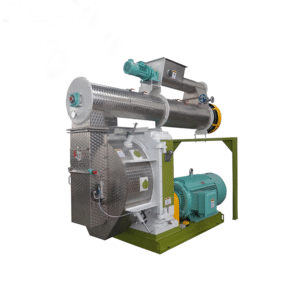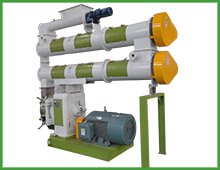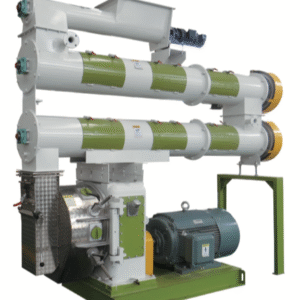Description
Technical Specifications & Design Innovation
Dual-Shaft Conditioning System
-
Primary Shaft: High-speed mixing (200-400 RPM) for rapid heat transfer
-
Secondary Shaft: Slow-speed kneading (50-120 RPM) for extended retention
-
Shaft Configuration: Counter-rotating with adjustable clearance
-
Power Requirements: 30-110 kW total drive capacity
Enhanced Conditioning Parameters
-
Retention Time: 120-300 seconds (adjustable based on moisture content)
-
Temperature Control: 85-95°C optimal for fiber modification
-
Steam Addition: 5-12% dry saturated steam at 4-7 bar
-
Liquid Binding Agents: 2-5% addition capability
Specialized Pelletizing Components
-
Die Design: Extended thickness (60-150 mm) for high-fiber formulations
-
Die Materials: Tungsten carbide inserts for abrasive resistance
-
Roller Configuration: Deep-grooved design for enhanced grip
-
Compression Ratio: 1:8 to 1:15 (adjustable for different fiber levels)
Processing Advantages for Distiller’s Grains
Moisture Management
-
Handles 25-35% moisture content in raw distiller’s grains
-
Reduces final pellet moisture to 12-14%
-
Maintains consistent moisture distribution (±0.8%)
Fiber Modification
-
Increases soluble fiber content by 15-25%
-
Improves starch availability through fiber encapsulation breakdown
-
Enhances pellet binding through natural fiber lignification
Nutritional Preservation
-
Maintains protein quality during thermal processing
-
Reduces microbial contamination through pasteurization
-
Preserves fat content while improving stability
Performance Specifications by Animal Category
| Animal Type | Max DDGS Inclusion | Pellet Durability | Production Rate | Energy Consumption |
|---|---|---|---|---|
| Dairy Cattle | 40% | 90-92% | 8-18 t/h | 18-25 kWh/t |
| Beef Cattle | 35% | 88-90% | 10-20 t/h | 16-22 kWh/t |
| Swine | 30% | 85-88% | 6-15 t/h | 20-28 kWh/t |
| Poultry | 25% | 82-85% | 5-12 t/h | 22-30 kWh/t |
Quality Assurance Metrics:
-
Pellet Durability Index (PDI): 82-92%
-
Fines Generation: 4-8%
-
Starch Gelatinization: 35-50%
-
Fiber Digestibility Improvement: 12-18%
Economic & Operational Benefits
Cost Reduction Advantages
-
Raw Material Savings: 15-30% compared to traditional ingredients
-
Energy Efficiency: 20-35% better than single-shaft systems
-
Production Capacity: 25-40% higher throughput
-
Maintenance Costs: 15-25% reduction through balanced wear
Nutritional Economics
-
Improved feed conversion ratios (3-8% enhancement)
-
Reduced feed costs ($15-45/ton savings)
-
Enhanced animal performance through better nutrient utilization
-
Increased formulation flexibility
Case Study – Midwest Feed Mill:
After implementing double-shaft technology for DDGS pelleting:
-
Production capacity increased from 12 to 16 t/h
-
Pellet quality improved (PDI from 80% to 88%)
-
Energy consumption reduced by 24%
-
Formulation costs decreased by $28/ton
Technical Innovations & Custom Features
Intelligent Control Systems
-
Moisture sensors for real-time adjustment
-
Temperature profiling for optimal fiber modification
-
Automated recipe management for different DDGS sources
-
Predictive maintenance monitoring
Specialized Component Design
-
Abrasion-resistant alloys for extended component life
-
Advanced sealing systems for high-moisture environments
-
Custom die geometries for specific fiber characteristics
-
Enhanced cooling systems for temperature-sensitive nutrients
Process Integration
-
Pre-breaking systems for lump reduction
-
Liquid application systems for binders and additives
-
Automated quality monitoring
-
Data integration with plant management systems
Operational Guidelines & Best Practices
Raw Material Handling
-
Consistent moisture monitoring of incoming DDGS
-
Proper storage conditions to prevent spoilage
-
Regular testing for nutritional consistency
-
Strategic blending with other ingredients
Process Optimization
-
Optimal steam quality and pressure maintenance
-
Regular die and roller inspection
-
Proper conditioning temperature control
-
Consistent mixing and retention time management
Quality Control Protocols
-
Regular pellet durability testing
-
Moisture content verification
-
Nutritional analysis compliance
-
Microbial safety monitoring
Sustainability Impact & Future Development
Environmental Benefits
-
Reduces waste from ethanol production
-
Lowers carbon footprint through local ingredient utilization
-
Decreases land use for feed production
-
Enhances circular economy in biofuel operations
Technology Evolution
-
AI-driven process optimization
-
Advanced sensor technology for real-time quality control
-
Integration with renewable energy sources
-
Enhanced automation for consistent quality
Market Adaptation
-
Increasing DDGS inclusion rates in various animal diets
-
Expansion to other high-fiber co-products
-
Global technology transfer to emerging markets
-
Customization for specific regional ingredients





Reviews
There are no reviews yet.